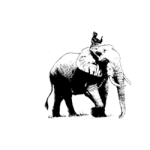 As with all species, our brains are designed to recognize certain things and disregard or minimize the importance of other things. Face recognition, for example, is developed in humans at a very early point, beginning in the first month of life. Shankar Vedantam, in The Hidden Brain, discusses an experiment that he performed using his month old child, one he repeated a number of times. He wanted to see how well his daughter could track his face as he moved around her crib. To his surprise, she locked onto his face and did not look away as he walked completely around her crib. As Mr. Vedantam points out, this ability to locate and recognize faces is rooted to our primitive needs to survive. Differentiating between the draw of a mother’s face and that of a cuddly looking (predatory) animal is an important one.
As with all species, our brains are designed to recognize certain things and disregard or minimize the importance of other things. Face recognition, for example, is developed in humans at a very early point, beginning in the first month of life. Shankar Vedantam, in The Hidden Brain, discusses an experiment that he performed using his month old child, one he repeated a number of times. He wanted to see how well his daughter could track his face as he moved around her crib. To his surprise, she locked onto his face and did not look away as he walked completely around her crib. As Mr. Vedantam points out, this ability to locate and recognize faces is rooted to our primitive needs to survive. Differentiating between the draw of a mother’s face and that of a cuddly looking (predatory) animal is an important one.
Face recognition is so automatic in humans; we see them in the most unlikely places.
Face recognition is not the only brain activity to automate. As we learn and experience different physical, emotional, or mental activities, we transfer the learning from active attention to automated action. Cameron Carpenter demonstrates this point quite well in the following.
Notice, as one commenter does, that there was no music for him to follow, and beginning at minute 1:52 he is doing five different things at once.
There are times, however, when automatic processes can interfere with performance processes. Take the following test. It is a demonstration of the Stroop Effect – see how well you do.
As was just shown, even when we know what we are supposed to do, our automated brain can get in the way. The Stroop Effect demonstrates that performing a task counter to our automatic response can be difficult. Only by consciously focusing on the task and taking our time are we able to complete it successfully.
Here then is the caution on automatic responses – while they can enhance performance in some situations, they can also interfere with performance. They can be detrimental when trying to solve a problem. Sometimes we have to go beyond our assumptions or build in safeguards. For example, pilots are instructed and trained to rely on their instruments when IFR conditions exist, because reliance on physical senses while operating a plane can be misleading when there are no spacial cues. Pilots receiving this certification are taught to counter an automatic response and force themselves to read the dials for their own safety.
The challenge with automatic responses is that, usually, they are not obvious to us on an awareness level; we have to purposefully focus on them (e.g. countering the Stroop Effect). Before you can help your organization, you have to analyze the things you do automatically. Then you can ask yourself if these actions are helping you or holding you back. For those that are, the question then becomes, “What do you do to minimize the negative effect?”
There will be more on this.
